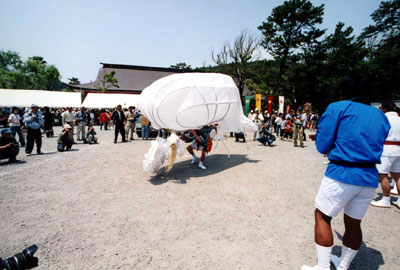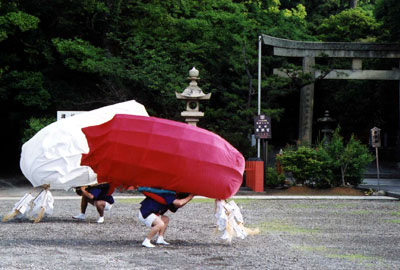Home > About > Performances > 38.Billowing cape
Horo is recorded in ”Shidaisho” (1622) as “neri sanjittan no ohoro” (the float consists of billowing capes as large as about 36 meters in length), and was sponsored by Koshiro, born in 1593 as the fourth son of Chaya Shiro Jiro Kiyonobu, a businessperson with political connections who served as a purveyor to Tokugawa Ieyasu, just as naginatafuri. It is believed that it was a spectacular sight as horo as heavy as 30 people’s billowing capes marched in the Togyo-Gyoretsu parade. In addition to this, three people performed with red horo sponsored by Gobo-cho. Horo also appeared in Gion Festival in Kyoto in the early Edo period, and it is considered a warrior performance along with naginagafuri and armored warriors.
Today, Wakamatsuri features red and white billowing capes. In the mid-Edo period people dressed as servants wearing happi (traditional festival costume) and keshomawashi (ornamental apron) carrying white billowing capes on their backs began to perform. It is recorded in Kiinokuni Meiisho Zue (1812) that people carrying white horo were dancing kujakumai choreography, based on what is believed to have turned into more of an art. Today, large white horo, slightly smaller red horo, and small horo carried by children march in the procession, saying “shomo, shomo,” and twirling their horo three times each side. On the morning of the day of Wakamatsuri, performers also visit houses in Wakaura for performance.

